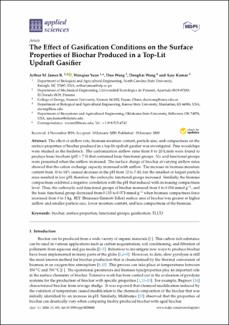Mostrar el registro sencillo del ítem
The Effect of Gasification Conditions on the Surface Properties of Biochar Produced in a Top-Lit Updraft Gasifier
| dc.contributor.author | James Rivas, Arthur | |
| dc.contributor.author | Yuan, Wenqiao | |
| dc.contributor.author | Wang, Duo | |
| dc.contributor.author | Wang, Donghai | |
| dc.contributor.author | Kumar, Ajay | |
| dc.date.accessioned | 2020-03-03T16:04:37Z | |
| dc.date.accessioned | 2020-03-03T16:04:37Z | |
| dc.date.available | 2020-03-03T16:04:37Z | |
| dc.date.available | 2020-03-03T16:04:37Z | |
| dc.date.issued | 2020-01-19 | |
| dc.date.issued | 2020-01-19 | |
| dc.identifier | https://www.mdpi.com/2076-3417/10/2/688 | |
| dc.identifier.other | https://doi.org/10.3390/app10020688 | |
| dc.identifier.uri | https://ridda2.utp.ac.pa/handle/123456789/10103 | |
| dc.identifier.uri | https://ridda2.utp.ac.pa/handle/123456789/10103 | |
| dc.description | The effect of airflow rate, biomass moisture content, particle size, and compactness on the surface properties of biochar produced in a top-lit updraft gasifier was investigated. Pine woodchips were studied as the feedstock. The carbonization airflow rates from 8 to 20 L/min were found to produce basic biochars (pH > 7.0) that contained basic functional groups. No acid functional groups were presented when the airflow increased. The surface charge of biochar at varying airflow rates showed that the cation exchange capacity increased with airflow. The increase in biomass moisture content from 10 to 14% caused decrease in the pH from 12 to 7.43, but the smallest or largest particle sizes resulted in low pH; therefore, the carboxylic functional groups increased. Similarly, the biomass compactness exhibited a negative correlation with the pH that reduced with increasing compactness level. Thus, the carboxylic acid functional groups of biochar increased from 0 to 0.016 mmol g−1, and the basic functional group decreased from 0.115 to 0.073 mmol g−1 when biomass compactness force increased from 0 to 3 kg. BET (Brunauer-Emmett-Teller) surface area of biochar was greater at higher airflow and smaller particle size, lower moisture content, and less compactness of the biomass | en_US |
| dc.description.abstract | The effect of airflow rate, biomass moisture content, particle size, and compactness on the surface properties of biochar produced in a top-lit updraft gasifier was investigated. Pine woodchips were studied as the feedstock. The carbonization airflow rates from 8 to 20 L/min were found to produce basic biochars (pH > 7.0) that contained basic functional groups. No acid functional groups were presented when the airflow increased. The surface charge of biochar at varying airflow rates showed that the cation exchange capacity increased with airflow. The increase in biomass moisture content from 10 to 14% caused decrease in the pH from 12 to 7.43, but the smallest or largest particle sizes resulted in low pH; therefore, the carboxylic functional groups increased. Similarly, the biomass compactness exhibited a negative correlation with the pH that reduced with increasing compactness level. Thus, the carboxylic acid functional groups of biochar increased from 0 to 0.016 mmol g−1, and the basic functional group decreased from 0.115 to 0.073 mmol g−1 when biomass compactness force increased from 0 to 3 kg. BET (Brunauer-Emmett-Teller) surface area of biochar was greater at higher airflow and smaller particle size, lower moisture content, and less compactness of the biomass | en_US |
| dc.format | application/pdf | |
| dc.language | eng | |
| dc.language.iso | eng | en_US |
| dc.rights | https://creativecommons.org/licenses/by-nc-sa/4.0/ | en_US |
| dc.rights | https://creativecommons.org/licenses/by-nc-sa/4.0/ | |
| dc.rights | info:eu-repo/semantics/openAccess | |
| dc.subject | biochar | en_US |
| dc.subject | surface properties | en_US |
| dc.subject | functional groups | en_US |
| dc.subject | gasification | en_US |
| dc.subject | TLUD | en_US |
| dc.subject | biochar | |
| dc.subject | surface properties | |
| dc.subject | functional groups | |
| dc.subject | gasification | |
| dc.subject | TLUD | |
| dc.title | The Effect of Gasification Conditions on the Surface Properties of Biochar Produced in a Top-Lit Updraft Gasifier | en_US |
| dc.type | info:eu-repo/semantics/publishedVersion | |
| dc.type | info:eu-repo/semantics/article |
